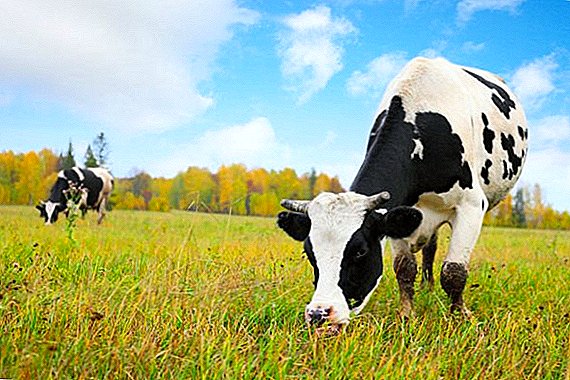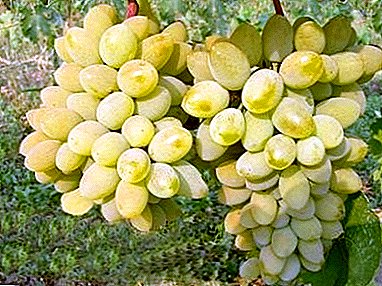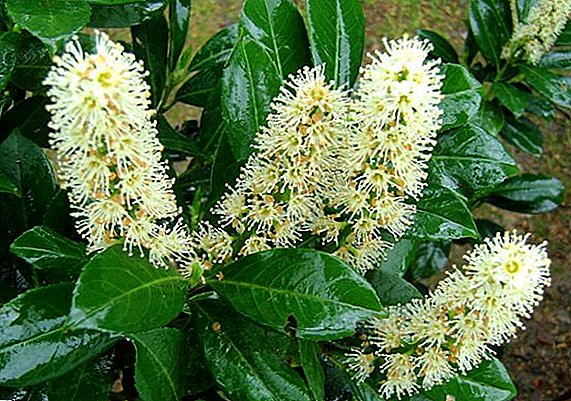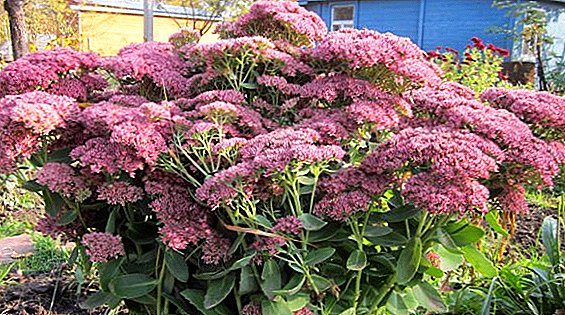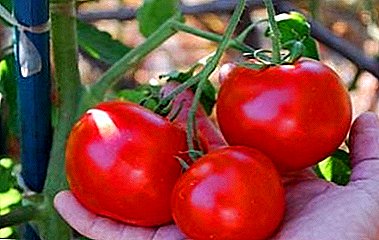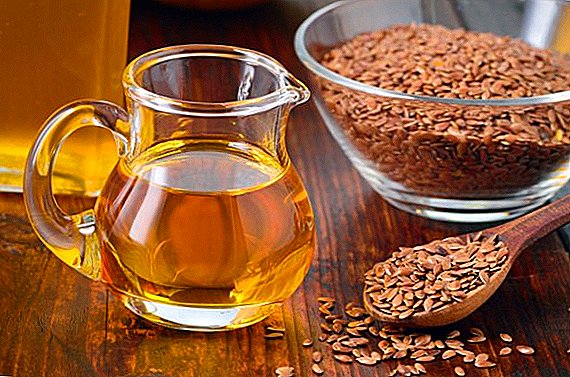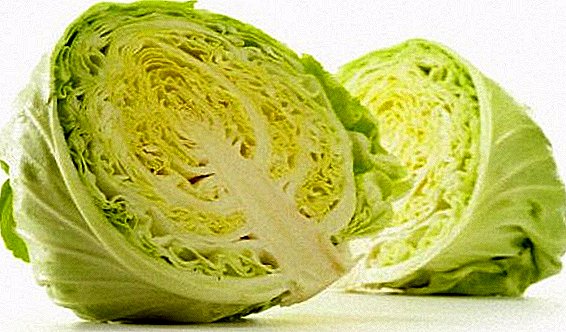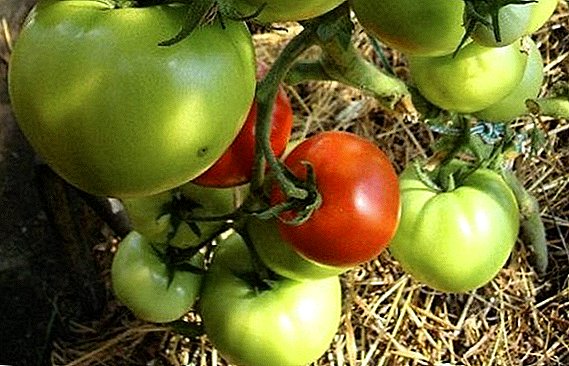 When choosing early and middle-early varieties of tomatoes, you should pay attention to a hybrid called Love F1.
When choosing early and middle-early varieties of tomatoes, you should pay attention to a hybrid called Love F1.
This type of tomato fell in love with gardeners for its excellent taste, good yield and durable immunity to various diseases.
Variety description
Tomato Love is a variety of tomatoes of early and mid-early ripening, determinant type, intended for cultivation in open ground and film shelters.
Did you know? This variety was bred in 2009 by breeders from the Russian Federation. Due to the excellent taste and attractive appearance of the fruit, it quickly gained popularity among vegetable growers.
The tomato belongs to medium-sized shtamba plants, whose growth reaches 120-130 cm. In greenhouse conditions it can grow up to 150 cm. The plant is distinguished by a dense foliage of medium size with the color of the leaf plates of the classic green color. The inflorescence is simple. On one brush, as a rule, 5-6 brushes are formed. The first brush is formed in the sinus of the seventh, sometimes ninth leaf. The yield of high-quality vegetables is more than 96%.
 Among the main advantages of the variety gardeners say:
Among the main advantages of the variety gardeners say:
- high taste of tomatoes;
- early ripening;
- resistance of fruits to cracking;
- strong immunity and resistance to diseases;
- possibility of use in pickling and conservation;
- undemanding to watering.
- requirements for fertilizers, especially during growth;
- possible leaf curliness;
- leaf fall;
- mandatory sustained backup.
Fruit characteristics and yield
The hybrid belongs to grades with early and average term of maturing. After 105-110 days after disembarkation, the process of fruiting begins.
To hybrid varieties of tomatoes also include: "Bokele F1", "Openwork F1", "Red cheeks", "Crimson Miracle", "Golden Stream", "Earthly Love".
The fruits of tomato Love have a rounded, even shape, with a very strong skin that is resistant to cracking. The color of the tomato is uniform, red or dark crimson, without any inclusions of green in the area of the stem. The flesh is dense, firm, uniform, bright red hue, different sweet-sour taste. The size of the fruit is quite large, of the same size, weighing 200-300 g. The main advantage of the type is the high commercial quality of the fruit.  The average yield of tomatoes, from one bush, you can get about 6 kg of tomatoes. With competent agricultural technology from 1 square. m collect 19-20 kg of tomatoes. Fruits of a grade universal, perfectly are suitable both for fresh use, and for preparation of various dishes, preservation, salting.
The average yield of tomatoes, from one bush, you can get about 6 kg of tomatoes. With competent agricultural technology from 1 square. m collect 19-20 kg of tomatoes. Fruits of a grade universal, perfectly are suitable both for fresh use, and for preparation of various dishes, preservation, salting.
Did you know? Tomatoes are biological relatives of potatoes and tobacco and belong to the family of solanaceous.
Selection of seedlings
The quality of the plant and its yield in most cases will depend on the seedlings. When choosing it, you need to pay attention to the following aspects:
- Age. It is recommended to choose plants aged no more than 45-60 days. At the same time on one site should pick up seedlings of approximately the same age.
- Height. The optimum height of the plant is 27-30 cm. In addition, the number of sheets on the trunk should not exceed 6-8 pieces.
- Stem. It is better to give preference to seedlings with a thick, durable stem with full-fledged, “live” leaves of a saturated green color.
- Root system The root should be strong, well-shaped, without obvious damage, rot and signs of mold.
- Leaves. Experts recommend to pay attention to the color of the leaves and their condition. Shriveled, deformed leaflets may indicate the development of infectious diseases. The presence of brown spots on the surface is a sign of various ailments or parasites. Too green leaves, a little twisted down, say that the plant was grown in an accelerated method using a large amount of nitrogen fertilizers.
 You should not purchase seedlings from containers in which they are located too closely to each other, because the plants can damage the root system. It is not recommended to buy plants from plastic bags. The most reliable way to shop is from proven people, familiar gardeners or in specialized stores. And the best to grow their own seedlings.
You should not purchase seedlings from containers in which they are located too closely to each other, because the plants can damage the root system. It is not recommended to buy plants from plastic bags. The most reliable way to shop is from proven people, familiar gardeners or in specialized stores. And the best to grow their own seedlings.
Learn how to choose the best planting dates for tomato seedlings.
Growing conditions
Tomato Love grown in open ground or in greenhouse conditions. For planting, it is better to choose areas with soil with low acidity, rich in potassium, calcium, nitrogen and phosphorus. If the level of soil acidity is below 6.0, then it is recommended to add lime to it, if the indicator is more than 6.8, then it is necessary to dilute the soil with sulphate granules.
An excellent variety takes root on soils enriched with organic manure or compost, which give the plant the nutrients it needs to grow and develop. If the ground is too dense, then you should add to it, to facilitate the structure, such as peat or sand. It is best to plant tomatoes in the area where previously grew cucumbers, carrots, parsley, cauliflower.  For the cultivation of this variety of tomato is recommended to choose sunny areas of land without drafts and the presence of strong winds. When planting in greenhouses, temperature indicators should be + 18-20 ° C.
For the cultivation of this variety of tomato is recommended to choose sunny areas of land without drafts and the presence of strong winds. When planting in greenhouses, temperature indicators should be + 18-20 ° C.
Important! Overheating of a plant is equally destructive, as well as frosts, so on hot days it is necessary to open and ventilate the greenhouse for a while.For the rapid growth and development of culture should adhere to a moisture level in the range of 50-60%. Increased humidity can lead to the development of infectious diseases and rotting of the root system. Since the variety belongs to heat-loving, then on cloudy days in the greenhouse additional lighting should be arranged by means of lamps of artificial light.
Seed preparation and planting
Getting a high yield requires the cultivation of high-quality seedling material. The best time for planting seeds is the end of March - the beginning of April. The preparation process is simple, but requires several important rules to be followed:
- Selection of seeds. Good, strong seedlings are obtained only from heavy, full grains. To separate dry seeds, it is recommended to lower the seeds in salted water: heavy seeds will go down, empty ones will remain floating on the surface.
- Immunity strengthening and processing. To make the seeds less prone to various diseases, it is recommended to hold them for 20-25 minutes in a weak solution of potassium permanganate. Next, you should put the material in a nutrient solution, which can be folk remedies, for example, aloe juice or potatoes, or commercial preparations - sodium humate, "Appin".
- Soak. Treated seeds should be laid out on gauze cloth, immersed in warm water at a temperature of + 24-25 ° C and left for 12 hours, changing the water periodically.
- Hardening Already crooked grains are subjected to the process of hardening. To do this, they are first placed in the refrigerator for 12 hours, then heated at +20 ° C for 12 hours. The procedure must be repeated several times.


When the preparation of seeds is finished, you should proceed to their landing in the ground:
- In the prepared container (disposable cups or ready-made containers) you need to fill the soil, fertilized by any means to stimulate growth.
- In the ground you need to make small pits and place them one grain. Sprinkle with a thin layer of soil.
- A container with sown seeds should be placed in a warm place in which the temperature reaches +25 ° C. Above, to create a greenhouse effect, the capacity is recommended to cover the film.
- From time to time, before the emergence of shoots, it is necessary to moisten the soil.
- At emergence of shoots the film needs to be removed, and to seedling to move to well lit, warm place.
Video: Sowing seeds for seedlings Immediately before planting in the ground hold hardening shoots. To do this, they are taken out on the street: in the first days by 1-2 hours, then the time is increased by an hour daily.
Did you know? It is surprising that wild tomato fruits weigh no more than 1 g, while fruits of cultivated varieties can reach a weight of 1 kg.
Maintenance and care
From mid-May, you can already begin to plant seedlings on the site. Planting is carried out according to the traditional 4x1 scheme, i.e., four plants are planted on 1 square meter. m. Between the bushes, the distance should be not less than 45 cm, between rows - at least 75 cm.
After 18-20 days after planting, it is necessary to carry out the first dressing, an ideal option for which can be green tea: for 50 liters of water, 4-5 kg of any green crushed grass should be taken, and ash and mullein should be added. This means you need to water each bush, at the rate of one plant 1.5 liters of feeding.
Watering tomatoes is carried out every 4-5 days. To moisten the soil using warm water, a temperature of not less than +18 ° C. Water the tomatoes directly under the root, without affecting the leaves, otherwise it may cause foliage to rot.  After the first inflorescence appears on the seedling, the stem should be formed into two stems. During staking, remove the lower, weak, dried, secondary leaves that take nutrients from the plant. Masking is repeated every 10-14 days. It is important to remember that pasynkovaniye should be carried out only when the very first, powerful and strong stem has developed on a tomato.
After the first inflorescence appears on the seedling, the stem should be formed into two stems. During staking, remove the lower, weak, dried, secondary leaves that take nutrients from the plant. Masking is repeated every 10-14 days. It is important to remember that pasynkovaniye should be carried out only when the very first, powerful and strong stem has developed on a tomato.
During the active growth phase, a tomato especially needs phosphorous and potash supplements. When the process of fruit ripening begins, only organic fertilizers are applied to the soil.
Since the fruits of tomato are quite heavy and large, the bush should be tied up. As a rule, such an event is carried out after the first fruits appear on the plant. Tie tomatoes in the usual way: with the help of pegs and ribbons of soft fabric.
Important! Ignoring the stage of garter plants can lead to rotting, deformation of the fruit and, as a consequence, a significant reduction in yield.
Disease and pest prevention
Tomatoes - plants that are often exposed to various fungal diseases, as well as pests. Despite the fact that the variety Love has a strong immunity, some of the ailments can manifest themselves:
- Leaf spot - It is expressed in the appearance of brown spots on the leaves, sometimes with a gray bloom. The severe stage of the disease ends with the fall of the foliage and the death of the plant. The most common cause of the disease is excessive soil moisture. To get rid of the disease, it is recommended to remove the top layer of the soil, as well as to treat the greens with copper oxychloride solution (35 g of product per 10 l of water).
- Fomosis rot - it is possible to determine the disease by a brown spot located near the stem. Further, the disease spreads into the fetus. A characteristic symptom of the disease is the presence of numerous spots of brown color on the foliage, which gradually increase. To combat the disease used drugs "Fundazol", "Barrier", "Home" or Bordeaux mixture. For preventive purposes, disinfect the soil.


Among the pests for tomato Love are considered the most dangerous:
- Colorado beetle - eats tomato leaves, stalks, and sometimes fruits. Defeating a pest can be done by spraying plants with chemicals specially developed for this (“Mospilan”, “Aktara”, “Corado”, etc.).
- White fly - It settles on the underside of the leaves, feeds on the sap of the plant, which leads to its exhaustion and death. To destroy the pest use special preparations "Konfidor" or "Pegas" or folk remedies, for example, tincture of garlic (100 g of minced garlic is added to 1 liter of water).


Familiarize yourself with the main types and characteristics of insecticides.
Harvesting and Storage
Harvest as fruits ripen, about 90-105 days after transplanting. Due to the fact that the fruits have a strong skin that is resistant to cracking, they are well tolerated in transportation and can last for a long time. It is important not to delay harvesting, as overripe fruits begin to rot, become soft, lose their taste. Some green tomatoes are also allowed. In such cases, full ripening takes place within one month.  Peeled tomatoes can be stored in a cold, dry place or refrigerator for quite a long time. For storage it is better to use wooden boxes, which are placed in a well-ventilated place, with a temperature of + 14-16 ° C. Periodically it is recommended to inspect the fruit, clean soft or rotted.
Peeled tomatoes can be stored in a cold, dry place or refrigerator for quite a long time. For storage it is better to use wooden boxes, which are placed in a well-ventilated place, with a temperature of + 14-16 ° C. Periodically it is recommended to inspect the fruit, clean soft or rotted.
Love's Tomatoes are tasty, juicy and apparently very attractive tomatoes, which are excellent for fresh use and for preparing preparations for the winter. Timely, proper care of the plant, regular feeding and hydration, pest control will allow even an inexperienced gardener to grow good seedlings and get a high yield of fruits of excellent quality.


